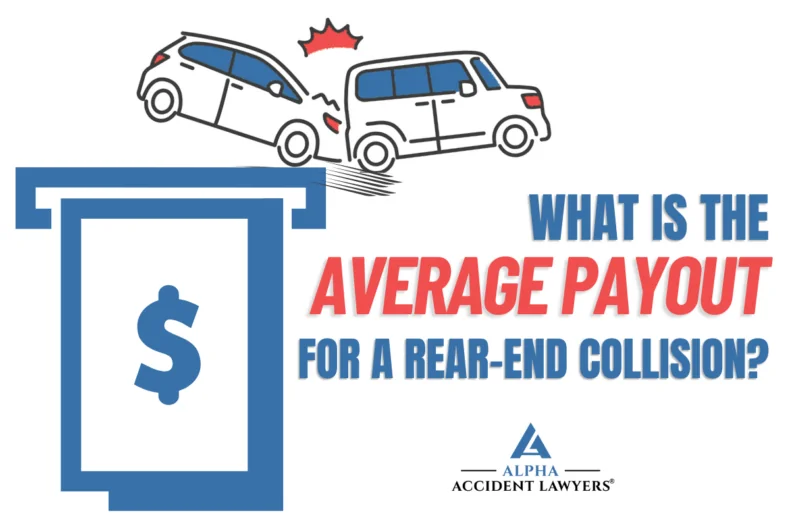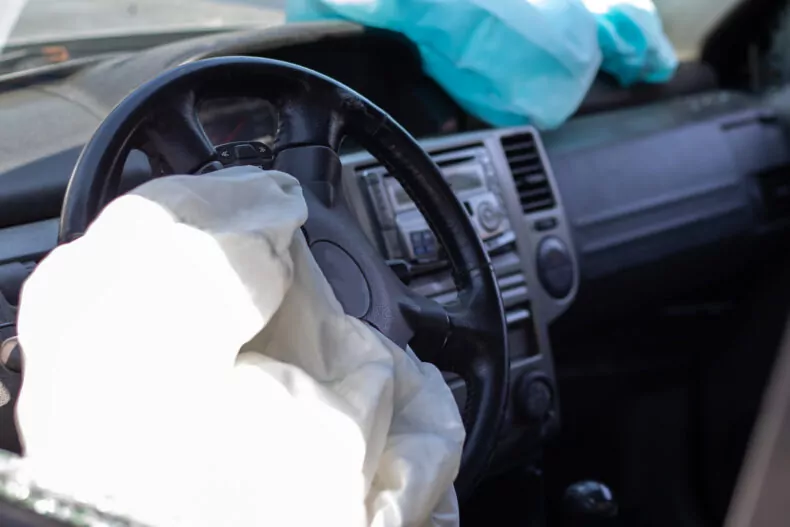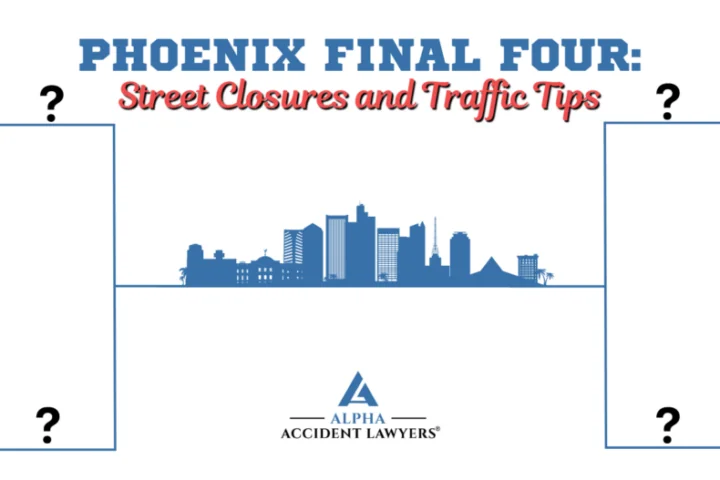What Is the Average Payout for a Rear-End Collision?
On average, a person may experience a car accident about every 18 years. This is how often the car insurance industry projects a person will submit a claim for a collision. While these are stats for one person, consider that there are around 333 million people in the United States. Around 29% of car crashes are rear-end collisions.
In 2020, nearly 2,500 people lost their lives in rear-end accidents across the US. Rear-end accident victims experience losses including personal injuries, medical bills, loss of quality of life, and financial strain.
If you’re wondering, what is the average payout for a rear-end accident? It depends on the circumstances of the car accident case. Keep reading to learn about the average rear-end collision settlement.
How Are Rear-End Settlements Determined?
If your accident resulted in injury, the payout will vary based on factors such as serious injuries, lost wages, and property damage. In some rear-end accident cases, the overall settlement price could range from a few thousand to a few hundred thousand. Typically, settlements are higher in cases where extensive damage or serious injuries are involved.
If you were injured in a rear-end car accident, the type of injury you endured and the severity of it are significant factors. Overall, if you are in a rear-end collision that results in serious injuries, the settlement payout will often be more. One of the reasons for this is that you will require medical attention. You may even need rehabilitation and ongoing therapy.
Additionally, you may have to miss work after a car accident. Therefore, the rear-end car accident settlement must reflect the time, money, and opportunities you will miss. It’s best to consult with a personal injury attorney who can help you calculate the true value of your rear-end accident settlement.
Generally, awarded settlements are 3.5 times higher when you have an experienced car accident lawyer on your side. To pursue the maximum compensation for your accident, it’s essential to take the following actions:
- Receive medical treatment and document your injuries. Also, gather your medical records and bills related to the rear-end accident.
- Secure legal counsel and file a car accident claim as soon as possible.
- Preserve every piece of evidence available to you from the rear-end accident.
How Long Will It Take To Get a Rear-End Accident Settlement?
If you work with an experienced attorney, you have a higher chance of getting a higher payout and you could also have your claim paid out in just a few weeks, or it could take a few months.
Sometimes, it could take years, but with a knowledgeable accident attorney, you may receive a higher payout within a faster time frame.
Does Location Affect Payout for Rear-End Collision?
Suppose you live in an urban area. In that case, the chance of motor vehicle accidents is much higher due to a higher number of cars and traffic congestion. This also includes higher numbers of pedestrians, bicyclists, construction, and other motorists on the road.
This means that the insurance coverage limit in urban areas will often be higher than in suburban towns, sometimes twice as high. Although rural areas have higher fatality rates, they typically have cheaper insurance policy options because the roads are less congested and there is a reduced number of motor vehicles and pedestrians.
However, this can depend on the policyholder’s specific location and insurance company. Therefore, the insurance policies of the motorists involved in the rear-end accident can affect the amount of compensation that can be recovered.
Rear-End Accident Payouts Vary
The average payout for a rear-end collision may vary. Every state has specific laws, and your location may affect your case. For example, it can depend on whether you are in an “at-fault” state or a “no-fault” state.
At-Fault States
At-fault states require insurance companies to pay for any damages to the parties involved. Also, the person who caused the accident will be liable to pay for any damages or injuries caused by others. California, for example, is an at-fault state.
If you are in a car accident and the other driver is found to be at fault, that person can be held responsible for any personal injuries, property, or vehicle damage. Additionally, any out-of-pocket expenses you’ve had to spend will be calculated in your rear-end accident settlement amount. In this case, you will file an insurance claim with the other driver’s insurance company to pursue compensation.
However, it is important to note that the other driver’s insurance policy may have coverage limits that do not cover all of the compensation you are owed.
No-Fault States
If you live in a no-fault state, no matter who was at fault in an accident, all persons involved will need to request compensation from their own insurance company. Therefore, there is no need for the parties involved in a car accident to prove who caused the accident. This does, however, depend on the severity of the accident, damages, and injuries suffered by the victims.
In true no-fault states, drivers are required to carry personal injury protection insurance (PIP). Another word for PIP is no-fault insurance. It covers expenses associated with medical care, property damage, and lost wages from missed work. This type of policy will also include your passengers.
What Is the Difference Between Payout Fluctuations Based on Policy?
The car insurance policy you have makes a difference in what can be paid out for rear-end accident settlements. This is because your policy’s limit is the primary restraint, which stops an insurance company from covering specific amounts, as they can only cover up to the cap off of your chosen policy.
Therefore, it’s best to consult with a car accident attorney when seeking compensation from the other party’s insurance company. An experienced personal injury lawyer will know how to properly calculate all of the losses including subjective damages such as pain and suffering. Loss in quality of life, missed business opportunities, and missed work should also be considered.
Economic Damages and Non-Economic Damages
Rear-end accidents can result in a variety of damages including economic and non-economic damages. Economic damages are financial losses that are typically easy to calculate.
Economic Damages
Some examples of economic damages can include:
Lost Income
If you lost wages at work, in order to heal from your injuries and rehabilitate, you can pursue compensation for these losses in a rear-end accident claim. Ensure you keep your paystubs as evidence of your lost wages.
Medical Expenses
Medical expenses often make up a large portion of settlement payouts. Hiring a personal injury lawyer when pursuing compensation for extensive medical bills is essential to recovering full and fair compensation.
Property Damage
In cases where personal property, such as a vehicle or belongings, is damaged or destroyed due to someone else’s negligence, the injured party may seek compensation for the repair or replacement costs.
Rehabilitation and Therapy
Compensation may be sought for the costs of rehabilitation, physical therapy, occupational therapy, or other forms of therapy necessary for the injured person’s recovery and rehabilitation.
Non-Economic Damages
Non-economic damages are more subjective losses including pain and suffering. A few examples of non-economic damages include the following:
Physical Injuries
Pain and suffering from physical injuries are eligible to be included in a settlement. Accident lawyers will often use the multiplier method to help get you the best payout for the pain and suffering that you experienced. This is when a lawyer will add the amount of damage done and multiply it based on the level of pain experienced by the complainant.
Scarring or Disfigurement
In cases where the accident results in visible scars or permanent disfigurement, the injured party may seek damages for the physical and emotional impact of these changes in their appearance.
Disfigurement can also account for any loss of bodily function or loss of limb.
Emotional and Mental Distress
Signs of emotional or mental distress are another concern. This would account for any adverse emotional reactions associated with the incident. Emotional distress damages cover the psychological impact of the accident, such as anxiety, mood swings, grief, fear, depression, or sleep disturbances, resulting from the traumatic event.
Emotional and mental distress can result from the shock of the accident itself or from feelings of guilt depending on the events of the accident.
Expert Help When You Need It
A rear-end collision can be taxing on your physical health, schedule, routine, and wallet without proper coverage. We understand the losses that auto accident victims deal with and fight to recover the maximum compensation available for our clients. Alpha Accident Lawyers handles more than just car accidents.
We handle incidents involving Uber and Lyft accidents, motorcycle accidents, pedestrian accidents, and more. We take pride in keeping your best interests in mind while we guide you throughout your entire personal injury case.
To pursue financial compensation for an accident you were involved in, allow us to fight for you and contact Alpha Accident Lawyers today.






